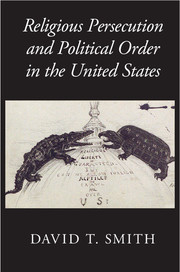Book contents
- Frontmatter
- Dedication
- Contents
- Acknowledgments
- 1 Introduction
- 2 Religious freedom and persecution in America: A theoretical overview
- 3 Joseph Smith and the rise of Mormonism: The political threat of religious charisma
- 4 The federal response to Mormonism
- 5 Jehovah's Witnesses and the flag salute, 1870–1940
- 6 Mass violence against Jehovah's Witnesses, 1940–1942
- 7 The Catholic experience in America
- 8 The Jewish experience in America
- 9 The Islamic experience in America
- 10 Conclusion
- Sources and bibliography
- Index
2 - Religious freedom and persecution in America: A theoretical overview
Published online by Cambridge University Press: 05 November 2015
- Frontmatter
- Dedication
- Contents
- Acknowledgments
- 1 Introduction
- 2 Religious freedom and persecution in America: A theoretical overview
- 3 Joseph Smith and the rise of Mormonism: The political threat of religious charisma
- 4 The federal response to Mormonism
- 5 Jehovah's Witnesses and the flag salute, 1870–1940
- 6 Mass violence against Jehovah's Witnesses, 1940–1942
- 7 The Catholic experience in America
- 8 The Jewish experience in America
- 9 The Islamic experience in America
- 10 Conclusion
- Sources and bibliography
- Index
Summary
INTRODUCTION
The central argument of this book is that in the United States, the protection of religious minorities from persecution has been contingent on state actors and their perceptions of threats to political order. If they regard religious minorities as a threat to political order, state actors are more likely to allow civil society to persecute them, or to join in the persecution. If, however, state actors see a greater threat in the persecution itself, they will act to protect religious minorities.
This explanation is at odds with the two dominant conceptual approaches to religious freedom in the United States. One approach sees religious freedom in America as preordained either by the constitution or by the conditions of religious pluralism that have existed since the colonial period. In this explanation, incidents of persecution have occurred throughout history, but these have ultimately expanded the legal conception of religious freedom that is always changing in the direction of greater inclusiveness. The other approach sees “religious freedom” as ideological cover for white, Protestant majoritarianism and views the persecution of religious minorities as normal, part of a broader system of social domination of all racial, ethnic, religious, and sexual minorities.
I argue that religious tolerance, enforced by the state, has frequently prevailed in America because state actors see religious intolerance as a threat to their own authority, or to the greater legitimacy of the order on which their authority rests. While this usually secures the long-term physical safety and political rights of religious minorities, breakdowns in religious tolerance have been frequent enough and violent enough to show the contingency of minority well-being on the threat perceptions of state actors. Sometimes the state sees them as the threat to be countered. Neither the constitution nor structural pluralism can protect religious minorities on their own; protection depends on which side the state takes in political conflicts.
In this chapter I construct and elaborate on this theory and suggest some likely conditions under which civic actors may succeed or fail in persuading state actors that a religious minority is a political threat. First, however, I contextualize this approach by outlining the strengths and weaknesses of existing approaches to religious freedom and persecution in the United States.
- Type
- Chapter
- Information
- Publisher: Cambridge University PressPrint publication year: 2015



